Computerized Assessment System for
English Communication

Since it came into full operation on Oct 2001, the accumulated total number of CASEC candidates is 1,518,551. (as of the end of March 2015)
Number of CASEC candidates
(accumulated figure and year-by-year figure)
Number of candidates: 1,518,551 accumulated candidates (as of end of March 2015)

The TOEIC® reference scores were derived by computing equivalent TOEIC scores for each CASEC score based on the aforementioned computed result. Also, respondents with a deviation of 100 or below for their reference score and self-reported score accounted for about 72% of the entire survey population.
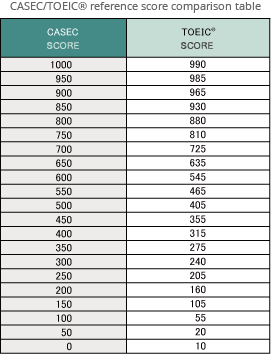
The scatter graph on the right shows the relationship between the CASEC total score and the self-reported TOEIC® score for CASEC candidates who reported their TOEIC® scores at the time of the test.
The correlation coefficient for the CASEC total score and self-reported TOEIC ® score is 0.84.

Based on the CASEC total score, the candidates were divided into 10 groups: 0 - 100, 101 - 200,..., 901 - 1000.
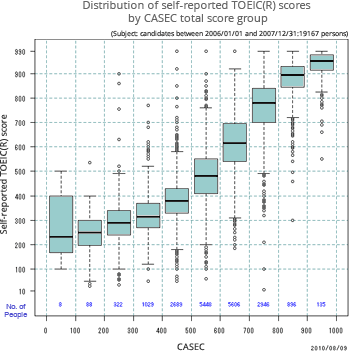
CEFR: Common European Framework of Reference for Languages: Learning, Teaching, Assessment (Council of Europe, 2001) describes foreign language proficiency at six levels ranging from A1 (beginner) to C2 (most advanced). Each level is defined by what a learner can do using a foreign language in real world. CEFR was developed by Council of Europe, and it is now acknowledged not only in Europe but also in many other parts of the world as one of the international standards of foreign language proficiency scale. Language teaching practitioners use CEFR as a reference for language curriculum design, material development, and comparison of different examinations such as TOEIC® and TOEFL®. CEFR is also helpful for hiring and training new employees.
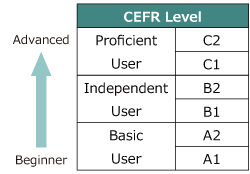
[ Procedure ]
We followed the procedure recommended in the Relating Language Examinations to the Common European Framework of Reference for Languages: Learning, Teaching, Assessment (CEFR) Manual (Council of Europe, 2009).
(1) Familiarization (The project members and panelists familiarize themselves with CEFR and the relating procedure)
(2) Specification (Content analysis of CASEC test items and its relevance to CEFR)
(3) Standardization Training & Benchmarking (Train panelists to develop a sense of CEFR levels)
(4) Standard Setting (Panelists relate a set of CASEC items to CEFR levels and decide borderlines between levels)
(5) Validation (Analysis and reflection of the overall process and results)
Note: We decided not to include Section 4 in the relating process at the moment due to the characteristics of its test format. While CEFR defines language proficiency in terms of things that a language learner can do using a foreign language in real-world situations, the task for CASEC Section 4 is partial dictation, in which the test taker is presented on the computer screen a few sentences with some words deleted, listens to the sentences, and types what he/she hears. Section 4 items do not necessarily simulate real-world situations.
[ Results ]

| Section 1 Score |
CEFR Level | Description |
|---|---|---|
195 ~ 250 |
B2 |
Has a vocabulary range sufficient for understanding both abstract and concrete texts on both familiar and unfamiliar topics normally encountered in personal, social, academic and vocational life. |
145 ~ 194 |
B1 |
Has a vocabulary range sufficient for understanding both general message and specific details in a sustained interaction or conversation on most topics pertinent to her/his everyday life. |
75 ~ 144 |
A2 |
Has a vocabulary range sufficient for understanding everyday social functions and daily-life transactions involving familiar situations and topics. |
0 ~ 74 |
A1 |
Has a vocabulary range sufficient for understanding basic everyday phrases, personal details, immediate concrete needs, and very familiar topics. |
| Section 2 Score |
CEFR Level | Description |
|---|---|---|
225 ~ 250 |
B2 |
Has a vocabulary range sufficient for understanding both abstract and concrete texts on both familiar and unfamiliar topics normally encountered in personal, social, academic and vocational life. |
165 ~ 224 |
B1 |
Has a vocabulary range sufficient for understanding both general message and specific details in a sustained interaction or conversation on most topics pertinent to her/his everyday life. |
85 ~ 164 |
A2 |
Has a vocabulary range sufficient for understanding everyday social functions and daily-life transactions involving familiar situations and topics. |
0 ~ 84 |
A1 |
Has a vocabulary range sufficient for understanding basic everyday phrases, personal details, immediate concrete needs, and very familiar topics. |
| Section 3 Score |
CEFR Level | Description |
|---|---|---|
225 ~ 250 |
B2 |
Can understand standard spoken language, live or broadcast, on both familiar and unfamiliar topics normally encountered in personal, social, academic or vocational life. |
200 ~ 224 |
B1 |
Can understand straightforward factual information about common everyday or job related topics, identifying both general messages and specific details. |
145 ~ 199 |
A2 |
Can understand phrases and expressions related to areas of most immediate priority (e.g. very basic personal and family information, shopping, local geography, employment) provided speech is clearly and slowly articulated. |
0 ~ 144 |
A1 |
Can follow speech that is very slow and carefully articulated, with long pauses for him/her to assimilate meaning. |
Council of Europe. (2001). Common European Framework of Reference for Languages: learning, teaching, assessment. Cambridge: Cambridge University Press.
The TOEFL iBT® reference scores were derived by computing equivalent range of TOEFL scores for each CASEC score based on the aforementioned computed result.
For CASEC scores of 450 points and under, however, the estimated TOEFL iBT® score range is defined uniformly as under 45 points. In the case of CASEC scores of 950 points or higher, the estimated TOEFL iBT® score is again defined uniformly as 100 points or over. This was done because few TOEFL® self-reported scores were available for candidates who obtained CASEC scores of 450 points or under and 950 points or over, so that the data was of low accuracy.
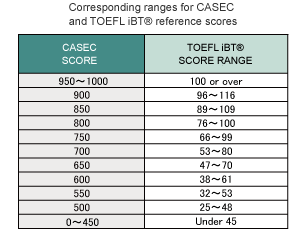
The scatter graph on the right shows the relationship between the CASEC total score and the self-reported TOEFL® score for CASEC candidates who reported their TOEFL® scores at the time of the test.
The correlation coefficient for the CASEC total score and self-reported TOEFL® score is 0.63.

Based on the CASEC total score, the candidates were divided into 10 groups: 0 - 100, 101 - 200,..., 901 - 1000.
The distribution of TOEFL® self-reported scores by group is shown in the box plot diagram on the right.
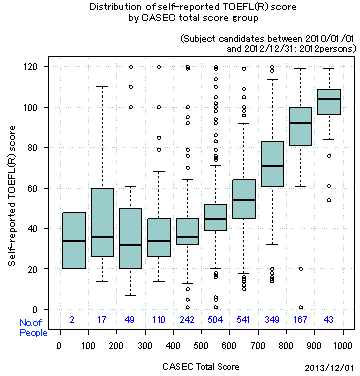
| Title: | Cases of CAT Adaptation and Effect Measurement in English Proficiency Measurement |
|---|---|
| Author: | Norio Hayashi (director of our company) |
| Journal title: | Measurement and Control |
| Publication matter: | Vol. 40(8) / pp. 572-575 / publication date: 20100810 |
| Title: | Practical use of computerized adaptive testing in Japan -Development and operation of “CASEC” |
|---|---|
| Authors: | N. Hayashi, Y. Nogami, K. Maeda, and H. Ikeda |
| Name of Society: | ICP-2004 at Beijing, China. August 13th, 2004 |
| Title | Author |
|---|---|
| Introduction to Item Response Theory - New Analysis Method for Language Test and Data |
Kenji Otomo (JIEM consultant) |
| Item Response Theory [Introduction] - The Science of Testing and Measurement |
Hideki Toyoda |
| Modern Test Theory | Hiroshi Ikeda (director and adviser of our company) |
| Item Response Theory - Basics and Application | Edited by Sukeyori Shiba |
| Applications of Item Response to Theory to Practical Testing Problems | FREDERIC M. LORD |
| Item Response Theory: Principles and Application | Ronald K. Hambleton, Hariharan Swaminathan |
| Fundamentals of Item Response Theory | Ronald K. Hambleton, Hariharan Swaminathan |
| Item Response Theory for Psychologists | SUSAN E. EMBRETSON, STEVEN P. REISE |
| Computerized Adaptive Testing: A Primer | HOWARD WAINER |